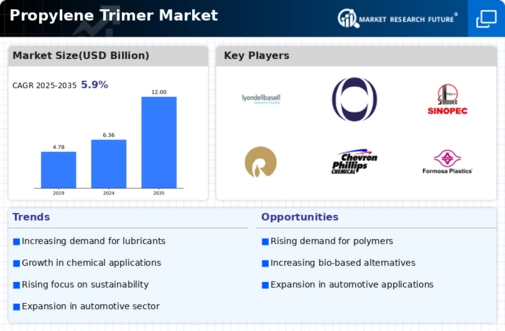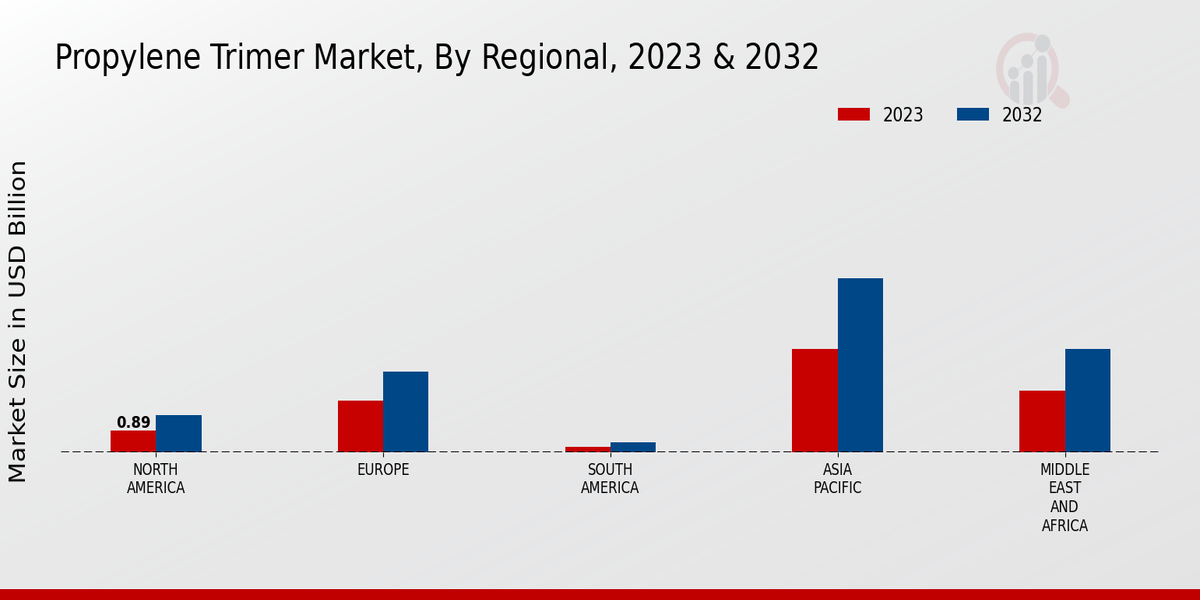Market Growth Projections
The Global Propylene Trimer Market Industry is projected to experience substantial growth over the coming years. With a market value of 6.36 USD Billion in 2024, the industry is expected to expand significantly, reaching 12.0 USD Billion by 2035. This growth trajectory indicates a compound annual growth rate (CAGR) of 5.91% from 2025 to 2035. Such projections reflect the increasing adoption of propylene trimer across various applications, including lubricants, adhesives, and chemical intermediates. The anticipated growth underscores the market's resilience and adaptability in meeting evolving consumer demands and industry standards.
Expansion in Chemical Manufacturing
The Global Propylene Trimer Market Industry is poised for growth due to the expansion of chemical manufacturing sectors worldwide. As propylene trimer serves as a crucial intermediate in producing various chemicals, its demand is likely to increase in tandem with the growth of the chemical industry. Countries with burgeoning manufacturing capabilities, particularly in Asia-Pacific, are expected to contribute significantly to this trend. The anticipated compound annual growth rate (CAGR) of 5.91% from 2025 to 2035 indicates a strong trajectory for the market, driven by the need for efficient and versatile chemical feedstocks. This expansion underscores the importance of propylene trimer in the evolving landscape of chemical production.
Growing Demand for Synthetic Lubricants
The Global Propylene Trimer Market Industry is experiencing a surge in demand for synthetic lubricants, which are increasingly favored for their superior performance and environmental benefits. These lubricants, derived from propylene trimer, offer enhanced thermal stability and reduced volatility compared to conventional mineral oils. As industries prioritize sustainability, the shift towards synthetic options is likely to drive market growth. In 2024, the market value is projected to reach 6.36 USD Billion, reflecting the rising adoption of these advanced lubricants across automotive and industrial applications. This trend suggests a robust future for the Global Propylene Trimer Market Industry as manufacturers adapt to evolving consumer preferences.
Regulatory Support for Sustainable Chemicals
The Global Propylene Trimer Market Industry is increasingly influenced by regulatory support aimed at promoting sustainable chemical production. Governments worldwide are implementing policies that encourage the use of environmentally friendly materials and processes, which aligns with the properties of propylene trimer. This regulatory landscape is likely to incentivize manufacturers to adopt greener practices, thereby enhancing the market's appeal to environmentally conscious consumers. As sustainability becomes a focal point in industrial operations, the Global Propylene Trimer Market Industry is expected to thrive, driven by compliance with regulations and the growing demand for sustainable products.
Rising Applications in Adhesives and Sealants
The Global Propylene Trimer Market Industry is witnessing a notable increase in applications within the adhesives and sealants sector. Propylene trimer's unique chemical properties make it an ideal component for formulating high-performance adhesives that exhibit excellent bonding strength and durability. The construction and automotive industries, in particular, are driving this demand as they seek reliable materials for assembly and insulation. As the market evolves, the integration of propylene trimer into adhesive formulations is likely to enhance product performance, thereby expanding its market share. This trend aligns with the projected growth of the Global Propylene Trimer Market Industry, which is expected to reach 12.0 USD Billion by 2035.
Technological Advancements in Production Processes
The Global Propylene Trimer Market Industry is benefiting from technological advancements in production processes that enhance efficiency and reduce costs. Innovations in catalytic processes and reactor designs are enabling manufacturers to produce propylene trimer with higher yields and lower energy consumption. These advancements not only improve the economic viability of production but also contribute to sustainability goals by minimizing waste and emissions. As companies invest in modernizing their facilities, the overall competitiveness of the Global Propylene Trimer Market Industry is likely to improve. This trend may attract new entrants and stimulate further growth, reinforcing the market's position in the global chemical landscape.















